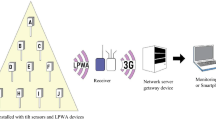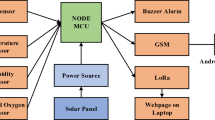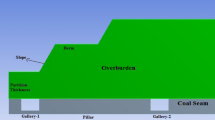Abstract
The increase in heavy rainfall events has contributed to the increase in floods and slope failures. These natural disasters can lead to severe loss of human lives. Monitoring and early warning may be the most promising ways to reduce the damage caused by natural disasters. Low-power wide-area networks (LPWANs) are new and efficient techniques for establishing monitoring methods. In this study, a new type of monitoring system, employing three types of LPWANs, was introduced. Radio wave propagation tests, monitoring data, and the effect of temperature on the inclination data were explained. The radio wave propagation tests were used to determine the proper locations for the gateway (GW) and sensors that comprise the monitoring system. The system was able to successfully collect the measurement data at each observation site. However, errors were still found in the measurement data for several reasons, such as electrical circuit problems, battery problems, and environmental effects. Moreover, an unstable correlation between temperature and the inclination data was observed. Thus, the moving average filter was applied in order to smooth out the fluctuations in the inclination data. Nonetheless, random noise was still present in the inclination data. It was determined, therefore, that only long-term inclination data trends should be used to predict displacement data.






























Similar content being viewed by others
Availability of data and materials
The data used in this work are available from the authors upon request.
References
Aalst MK (2006) The impacts of climate change on the risk of natural disasters. Disasters 30:5–18
Kundzewicz ZW, Kanae S, Seneviratne SI, Handmer J, Nicholls N, Peduzzi P, Mechler R, Bouwer LM, Arnell N, Mach K, Muir-Wood R, Brakenridge GR, Kron W, Benito G, Honda Y, Takahashi K, Sherstyukov B (2014) Flood risk and climate change: global and regional perspectives. Hydrol Sci J. https://doi.org/10.1080/02626667.2013.857411
Kim SW, Chun KW, Otsuki K, Shinohara Y, Kim MI, Kim MS, Lee DK, Seo JI, Choi BK (2015) Heavy rain types for triggering shallow landslides in South Korea. J Fac Agric Kyushu Univ 60:243–249. https://doi.org/10.5109/1526323
Panwar V, Sen S (2019) Economic impact of natural disasters: an empirical re-examination. J Appl Econ Res 13:109–139. https://doi.org/10.1177/2F0973801018800087
Wang F, Wu YH, Yang H, Tanida Y, Kamei A (2015) Preliminary investigation of the 20 august 2014 debris flows triggered by a severe rainstorm in Hiroshima city. Jpn Geoenviron Disast 2:1–16. https://doi.org/10.1186/s40677-015-0025-6
Uchimura T, Towhata I, Wang L, Nishie S, Yamaguchi H, Seko I, Qiao J (2015) Precaution and early warning of surface failure of slopes using tilt sensors. Soils Found 55:1086–1099. https://doi.org/10.1016/j.sandf.2015.09.010
Gan B, Jin S (2018) Design of early warning system based on wireless sensor network. Int J Online Eng 14:66–76. https://doi.org/10.3991/ijoe.v14i01.8060
Adelantado F, Vilajosana X, Peiro PT, Martinez B, Segui JM, Watteyne T (2017) Understanding the limits of LoRaWAN. IEEE Commun Mag 55:1–7. https://doi.org/10.1109/MCOM.2017.1600613
Queralta JP, Gia TN, Zou Z, Tenhunen H, Westerlund T (2019) Comparative study of LPWAN technologies on unlicensed bands for M2M communication in the IoT: beyond Lora and Lorawan. Proc Comput Sci 155:343–350. https://doi.org/10.1016/j.procs.2019.08.049
Park S, Lim H, Tamang B, Jin J, Lee S, Chang S, Kim Y (2019) A study on the slope failure monitoring of a model slope by the application of a displacement sensor. J Sens 2019:1–9. https://doi.org/10.1155/2019/7570517
Tamate S (2010) Penetration-type pipe strain gauge. US Patent No. 7,762,143 B2
Butler M, Angelopoulos D, Mahy D (2019) Efficient IoT-enabled landslide monitoring. IEEE. https://doi.org/10.1109/WF-IoT.2019.8767201
Tamate S, Hori T (2017) Study on monitoring for detection of potential risk of slope failure for labor safety. Geo-Risk. https://doi.org/10.1061/9780784480717.025
Kaafarani R, Jaoude GA, Wartman J, Tawk M (2019) Landslide susceptibility mapping based on triggering factors using a multi-modal approach. MATEC Web Confer. https://doi.org/10.1051/matecconf/201928102002
Putra AD, Toda H, Hafidz A, Matsuba K, Kimikado Y, Takahashi Y, Tsuzuki S, Kinoshita N, Yasuhara H (2021) Development of slope deformation monitoring system based on tilt sensors with low-power wide area network technology and its application. J Civ Struct Heal Monit 11:1037–1053. https://doi.org/10.1007/s13349-021-00494-9
He Z, Xie M, Huang Z, Lu G, Yan B, Wang J (2021) Method to realize the tilt monitoring and instability prediction of hazardous rock on slopes. Adv in Civ Eng. https://doi.org/10.1155/2021/9965113
Qiao S, Feng C, Yu P, Tan J, Uchimura T, Wang L, Tang J, Shen Q, Xie J (2020) Investigation on surface tilting in the failure process of shallow landslides. Sensors 20:1–29. https://doi.org/10.3390/s20092662
Xie J, Uchimura T, Wang G, Shen Q, Maqsood Z, Xie C, Liu J, Lei W, Tao S, Chen P, Dong H, Mei G, Qiao S (2019) A new prediction method for the occurrence of landslides based on the time history of tilting of the slope surface. Landslides 17:301–312. https://doi.org/10.1007/s10346-019-01283-8
Xie J, Uchimura T, Chen P, Liu J, Xie C, Shen Q (2019) A relationship between displacement and tilting angle of the slope surface in shallow landslides. Landslides 16:1243–1251. https://doi.org/10.1007/s10346-019-01135-5
Ishihara M, Shiina M, Suzuki S (2009) Evaluation of method of measuring distance between object and walls using ultrasonic sensors. J Asian Electr Veh 7:1207–1211. https://doi.org/10.4130/jaev.7.1207
Zhmud VA, Kondratiev NO, Kuznetsov KA, Trubin VG, Dimitrov LV (2018) Application of ultrasonic sensor for measuring distances in robotics. J Phys Conf Ser 1015:1–9. https://doi.org/10.1088/1742-6596/1015/3/032189
Koval L, Vaňuš J, Bilík P (2016) Distance measuring by ultrasonic sensor. IFAC-PapersOnLine 49:153–158. https://doi.org/10.1016/j.ifacol.2016.12.026
Lee J, Kim S, Jun H (2018) A study of the influence of the spatial distribution of rain gauge networks on areal average rainfall calculation. Water 10:1–17. https://doi.org/10.3390/w10111635
Andersen JS, Eriksson J (2017) Investigating the practical performance of the LoRaWAN technology. Linkoping University, Thesis
Qureshi UM, Aziz Z, Shaikh FK, Aziz Z, Shah SMZS, Sheikh AA, Felemban E, Qaisar SB (2016) RF path and absorption loss estimation for underwater wireless sensor networks in different water environments. Sensors 16:1–15. https://doi.org/10.3390/s16060890
Hossinuzzaman MD, Dahnil DP (2019) Enhancement of packet delivery ratio during rain attenuation for long range technology. Int J Adv Comput Sci Appl 10:219–225. https://doi.org/10.14569/ijacsa.2019.0101031
Ferreira AE, Ortiz FM, Costa LHMK, Foubert B, Amadou I, Mitton N (2020) A study of the Lora signal propagation in forest, urban, and suburban environments. Ann Des Telecommun 75:333–351. https://doi.org/10.1007/s12243-020-00789-w
Schulz WH, McKenna JP, Kibler JD, Biavati G (2009) Relations between hydrology and velocity of a continuously moving landslide-evidence of pore-pressure feedback regulating landslide motion? Landslides 6:181–190. https://doi.org/10.1007/s10346-009-0157-4
Panda KG, Agrawal D, Nshimiyimana A, Hossain A (2016) Effects of environment on accuracy of ultrasonic sensor operates in millimetre range. Perspect Sci 8:574–576. https://doi.org/10.1016/j.pisc.2016.06.024
TE Specification DPL-Series Inclinometer Module. http://www.te.com. Accessed 19 Oct, 2021
Acknowledgements
The authors thank the SECOM Science and Technology Foundation, Shikoku Create Association, and The Kurata Grants: The Hitachi Global Foundation. This work has also been supported by Dia Consultant Co., Ltd, Ryoden Corporation, Nishimatsu Construction Co., Ltd, OYO Corporation and Mcot Co., Ltd. The authors also thank Ministry of Land, Infrastructure, Transport and Tourism, Shikoku Regional Development Bureau. Their support is gratefully acknowledged.
Funding
This research project has been partly supported by the SECOM Science and Technology Foundation, Shikoku Create Association, and The Kurata Grants: The Hitachi Global Foundation.
Author information
Authors and Affiliations
Contributions
All the authors contributed to the study conception and design, material preparation, data collection, and data analysis. The first draft of the manuscript was written by Achmad Hafidz and all the authors commented on previous versions of the manuscript. All the authors have read and approved the final manuscript.
Corresponding author
Ethics declarations
Conflict of interest
The authors declare that they have no competing interests.
Additional information
Publisher's Note
Springer Nature remains neutral with regard to jurisdictional claims in published maps and institutional affiliations.
Rights and permissions
Springer Nature or its licensor holds exclusive rights to this article under a publishing agreement with the author(s) or other rightsholder(s); author self-archiving of the accepted manuscript version of this article is solely governed by the terms of such publishing agreement and applicable law.
About this article
Cite this article
Hafidz, A., Kinoshita, N., Yasuhara, H. et al. Development and applications of slope and river monitoring system using low-power wide-area network technology. J Civil Struct Health Monit 13, 83–100 (2023). https://doi.org/10.1007/s13349-022-00620-1
Received:
Revised:
Accepted:
Published:
Issue Date:
DOI: https://doi.org/10.1007/s13349-022-00620-1




